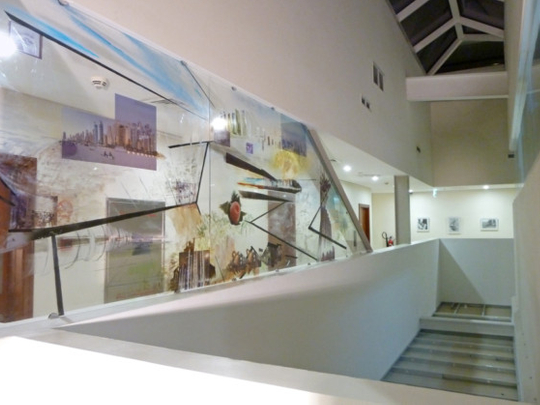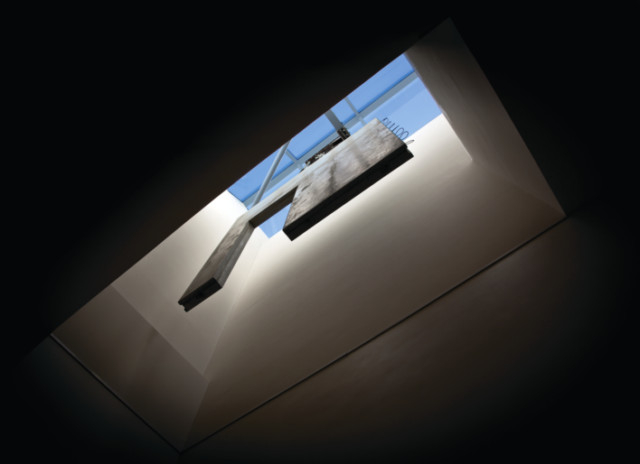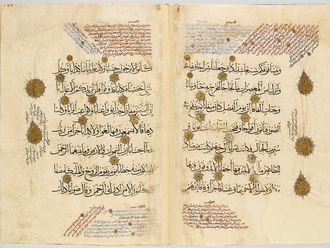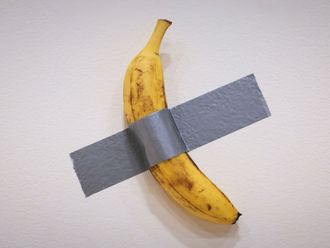
Dubai Community Theatre & Art Centre (DUCTAC) has launched a new arts initiative called “co.mmission”, under which local and international artists will be invited throughout the year to create artworks in and around the DUCTAC premises. Simon Coates, artist and curator of DUCTAC’s Gallery of Light, says, “The idea for the ‘co.mmission’ series is to show people that art is not just a painting on the wall or something you can touch. Our only brief to the artists is not to create something to be displayed within the gallery walls. Since the architecture at DUCTAC is such that there are many nooks, crannies and bizarre angles, we want to encourage artists to exploit this aspect of the premises.”
The two inaugural artworks in the “co.mmission” series have been created by Carla Mercedes Hihn and Vikram Divecha. Both artists have made good use of the unusual architecture of DUCTAC to create interesting site-specific installations that relate to the city.
Hihn is based in Berlin and her participation in the programme was supported by the Goethe-Institut Gulf Region. The German artist is interested in capturing the structures, views, memories and atmosphere of different cities in her work. She likes to work on transparent surfaces, and has chosen to do her mixed-media painting on a glass pane installed along an open corridor on the upper floor of DUCTAC, where art classes and workshops are held.
The artwork conveys the artist’s impressions of Dubai through a combination of photographs taken by her, archival pictures of the city, drawings and paintings. “This is my first trip to Dubai and I was curious to get to know such a young city. The two things that struck me the most are the speed with which everything moves, and that the city is broken up into different disconnected enclaves with specific functions. I have tried to capture the skyline of skyscrapers as seen through a speeding car. And I have depicted the workers in their housing compounds as the wheel that is powering the speed of Dubai. I have tried to show both the glitzy side of Dubai as well as the loneliness that exists in big cities through images of shopping malls, street performers, lonely figures sitting on benches and empty houses. The dynamic lines in my painting demarcate the different enclaves, while also representing the highways that connect them. The palm trees and oysters that form the backdrop of this work and the images of the Palm Jumeirah and Burj Khalifa tell the story of Dubai from the past to the present. I have also included a picture of an artificial sugar-coated tree that I saw in a candy store in a mall because it seems like such an apt comment on this city,” she says.
Hihn chose to put her work in a much used and open area because she wants it to interact with the surroundings. “I like the way the work changes with the changing light, and the fact that everybody who passes by in this corridor becomes a part of this collage. As people come closer they can see the different microcosms, and the transparent surface invites them to look beyond the images and think about what they stand for,” she says.
In stark contrast with Hihn’s art practice, Divecha uses construction materials and industrial-production methods to create installations that explore the urban environment and the effect of urbanisation and socio-economic changes on society. The Dubai-based Indian artist’s project, “Reclaimed Void”, features a 3x3.3-metre precast concrete panel, suspended from the ceiling in a hidden corner of DUCTAC, that extends all the way from the ground floor up to a skylight on the roof. The precast classic façade of a house with an opening for the door is not immediately visible from the reception area. As one approaches the hidden corner, the huge block of concrete suspended overhead appears quite intimidating. But when seen from the first floor, it is level with the floor and appears to be inviting viewers to walk in.
“Witnessing the rapid growth of Dubai has deeply influenced the themes, materials, structure and scale of my work. I ask all my questions about life against a background of concrete,” Divecha says. “The placement of my work in a hidden corner alludes to the public and private persona within every individual. And the fact that this is a home without a foundation makes viewers question their relationship with space, their homes and themselves. The way it is suspended in limbo in a big void speaks about the unsettled feelings we all carry within us, encouraging us to introspect and learn to reside comfortably within ourselves. The piece is precast from a mould and hence replicable, thus commenting on the collective human condition where everybody is in some way in a state of unrest. It also symbolises the lack of identity, individuality and erasure of cultures in modern urban life. The piece also alludes to the notion of reclaimed land, and to parts of Dubai or any city that are in an in-between stage of construction. Thus this work is about the act of reclaiming voids on various levels. And I love the irony and symbolism of a concrete artwork permanently suspended in a mall in Dubai,” he adds.
Jyoti Kalsi is an arts enthusiast based in Dubai.
The artworks are on permanent display at DUCTAC, Mall of the Emirates.












